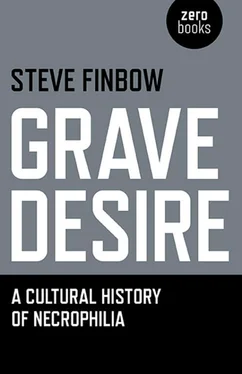This escalation in Bertrand’s necrophiliac desires results in an increase in his exhumation of and intercourse with corpses. In Lille, from late March over a period of a month, he disinterred four women and has sexual intercourse with their bodies before eviscerating and mutilating them. On a few occasions, the hardness of the ground made it impossible for him to dig up corpses, this happened in Doullens in early July, the summer sun baking the earth until Bertrand tore his nails trying to dig his way down. At the end of July, back in Paris, in the middle of the 1848 revolution, the guards at the regiment’s camp at Ivry-sur-Seine had it under lockdown but Bertrand’s desires meant he had to escape. Each night, he found a way out and made his way to Montparnasse cemetery. On the 25 thof July, he disinterred and had sex with the badly decomposed body of a twelve-year-old girl, after disembowelling her and mutilating her genitals, he masturbated over the corpse. One night, he dug up two bodies and carried them to a tomb where he would not be disturbed by the armed guards, he had sex with the body of a 60-year-old woman but left the corpse of the three-year-old girl untouched.
Were these acts sexual reproductions of the violence in French and European culture at the time? Marx wrote of the June days of the 1848 revolution that ‘The tricolour republic now bears only one colour, the colour of the defeated, the colour of blood. It has become the red republic.’ That ‘the Paris of the proletariat burned, bled and moaned in its death agony.’ And that ‘The June revolution is the ugly revolution, the repulsive revolution, because realities have taken the place of words, because the republic has uncovered the head of the monster itself by striking aside the protective, concealing crown.’ [112] Karl Marx, The Revolutions of 1848, (Harmondsworth, 1973), pp. 129-134.
Did the fomentation of social revolt lead to a fermentation of sexual rebellion, of revolting erotic desires?
In a cemetery closer to the camp in Ivry, over a period of a month, Bertrand copulated with the bodies of a girl aged seven and a woman in her late thirties, mutilating the young girl but not disembowelling either body. Finding Montparnasse too difficult to break into, Bertrand visited hospital and suicide graveyards. Unable to find the bodies of women, he took out his anger by digging up male corpses and, repulsed by them, slashing them with his sabre. In the space of four months, he exhumed fifteen bodies, only two of which were women. His anger and sexual frustration escalating, he had sex with the women, eviscerated them, split their mouths to a Joker smile, cut their bodies to ribbons, pulled at their limbs, twisting the bodies into grotesque shapes in an attempt to ‘destroy’ them, he would then masturbate.
Toward the end of this period of escalation, at 10pm on the 6 thof November, guards fired a shot at Bertrand as he climbed over the wall into the cemetery, the bullets missed and Bertrand waited two hours on cold and wet stone steps before re-entering. Once in, he dug up the recently buried body of a woman in her mid-twenties, a well-preserved victim of drowning. Again, he eviscerated her, mutilated her genitals, and made a deep cut through to the bone in her left thigh—with this corpse, he achieved a greater orgasm than with previous ones and hoped that the intensity would satiate his violent and dark desires.
His cravings were becoming uncontrollable and he stated that ‘[I]n all my violations of sepulchres, in no case was the act premeditated; when the attack got possession of me, whether at noon or at midnight, I had to go; it was impossible to postpone it.’ and in December guards shot at him, the bullet tearing through his greatcoat. He fled into the storm-ridden night but re-crossed the muddy fields to the Ivry cemetery where he attempted without success to exhume a corpse. In January 1849 in Montparnasse, another shot rang out as he escaped the traps the guards set for him and the dogs prowling the pathways.
Leaving the Luxembourg Gardens on Thursday the 15 thof March, Bertrand tried to break into Montparnasse by climbing the walls but a booby-trapped gun shot him. Bloodied from wounds along his right side, Bertrand arrived at the Val-de-Grâce military hospital at 11:30pm. The story of his wounds soon started circulating and became the gossip of soldiers. A Montparnasse cemetery gravedigger heard about the story and informed authorities, and police visited the hospital to arrest Bertrand. One of his surgeons, Dr Marchal de Calvi, took down Bertrand’s confession and the prosecution used the notes at Bertrand’s trial—as necrophilia did not exist as a crime, the court found Sergeant François Bertrand guilty of vampirism.
If the escalation in Bertrand’s perversions culminated in his capture, what were the origins of that perversion and what tipped dark fantasy into darker reality? As Foucault states, in the nineteenth century, ‘sex gradually became an object of great suspicion; the general and disquieting meaning that pervades our existence, in spite of ourselves; the point of weakness where evil portents reach through to us; the fragment of darkness that we each carry with us: a general signification, a universal secret, an omnipresent cause, a fear that never ends.’ [113] The History of Sexuality, p. 69.
In the opening decade of the twenty-first century, Philippines police dubbed a successor to Sergeant Bertrand the ‘Tomb Raider.’ At first, local residents thought a gang of necrophiles was responsible for the disinterred female corpses spread-eagled on tombs. In the small Barangay of Mercedes, over a period of six months between October 2009 and May 2010, local people found five bodies laid out on their own graves, all had been sexually abused. The victims ranged in age from an elderly woman to a 13-day-old girl. Other victims included a 17-year-old student and a female teacher found hanging naked from a post. After a few false leads, police arrested 19-year-old Randy Uro Galvez for breaking into tombs at two cemeteries in Mercedes. Nonito Toribio Sr., the acting caretaker of the Mercedes New Cemetery caught Galvez with a slab of wood and a stick with which he hammered open the tombs and desecrated them. In June 2010, the Philippines Government proposed Senate Bill 1038 making necrophilia illegal. Previously, sexual intercourse with a female corpse was ‘beyond the pale’ [114] Available at http://www.senate.gov.ph/lis/bill_res.aspx?congress=14&q=SBN1038
of the criminal justice system and the bill hoped to ‘plug this distinct lacuna in the law by penalizing necrophiles or those who morbidly derive sexual gratification by copulating with a corpse. That such forcible imposition of manhood is directed against a lifeless female does not make the grisly act and less detestable and heinous. In fact, this vicious bestiality is notoriously offensive and revolting to the feelings of the living even as it grossly desecrates the dead.’ The Senate passed the bill and imposed a death penalty for the crime. While Galvez awaited trial for the alleged assaults, in the Philippines town of San Jose, a cemetery worker discovered the exhumed naked body of 15-year-old high-school student Jay Molina who had been killed in a motor accident a week earlier; a medical examiner found evidence of rape.
Both Bertrand and the Tomb Raider suffer from ‘Ophelia’s Grave’ syndrome, acting out a desire to ‘Hold off the earth awhile / Till I have caught her once more in mine arms,’ [115] William Shakespeare, Hamlet, V. 1. 249-50.
the earth a return to the womb and a drive toward their own death. Like Laertes who ‘leaps into the grave and embraces the object whose loss is the cause of his desire, an object that has attained an existence that is all the more absolute because it no longer corresponds to anything in reality. The one unbearable dimension of possible human existence is not the experience of one’s own death, which no one has, but the experience of the death of another,’ [116] Jacques Lacan, ‘Desire and the Interpretation of Desire in Hamlet,’ trans. James Hulbert, Yale French Studies 55-56 (1977), pp 11-52.
both Bertrand and the Tomb Raider, like Marx’s Paris of June 1848, impose new realities, new sexual landscapes. For both men, the desecration of the grave, the act of exhumation, the laying out of the corpse, ritualized the act of necrophilia; Bertrand added mutilation to his sexual rites, whereas the Tomb Raider preferred humiliation—he left the body of the teacher hanging from a post suspended by her stockings with her underwear removed and placed over her head. Where Bertrand mostly placed the bodies back in the grave, the Tomb Raider left them on display—Bertrand a humble Laertes to the Tomb Raider’s histrionic Hamlet—each a double of the other, separated by a quarter of a millennium, they come together in an orgy of death, lust, and desecration. These examples of necrophilia stem from the stuff of myth, of vampires and werewolves, digging corpses from graves with their bare hands, smashing sepulchres with hammers, levering lids from coffins, grave robbers and bodysnatchers, an unholy amalgamation of Dracula, Ed Gein, and Burke and Hare, yet both men are classified as ‘classic’ or ‘regular’ necrophiles, what Wulffen termed ‘necrostuprum’ [117] See Erich Wulffen, Enzyklopadie de Modernen Kriminalistik, (Berlin, 1910).
or grave robbers, necrophiles who use already dead bodies as sex object. Although they mutilate, they do not murder to obtain a body.
Читать дальше












